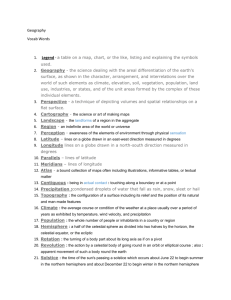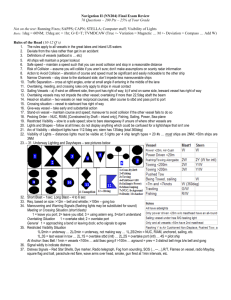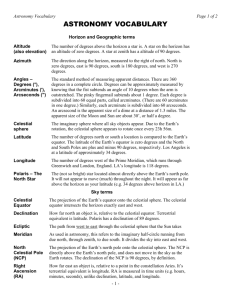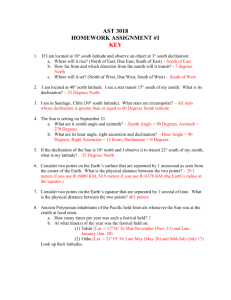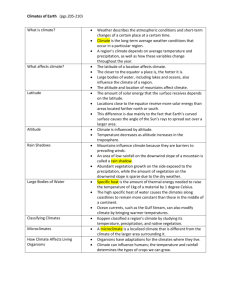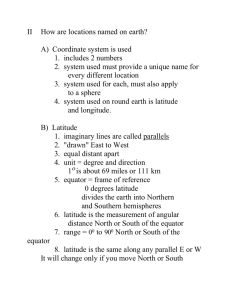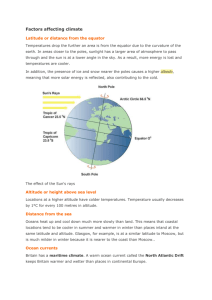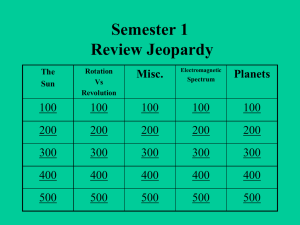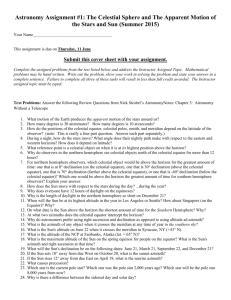NN204 Test II Review
advertisement
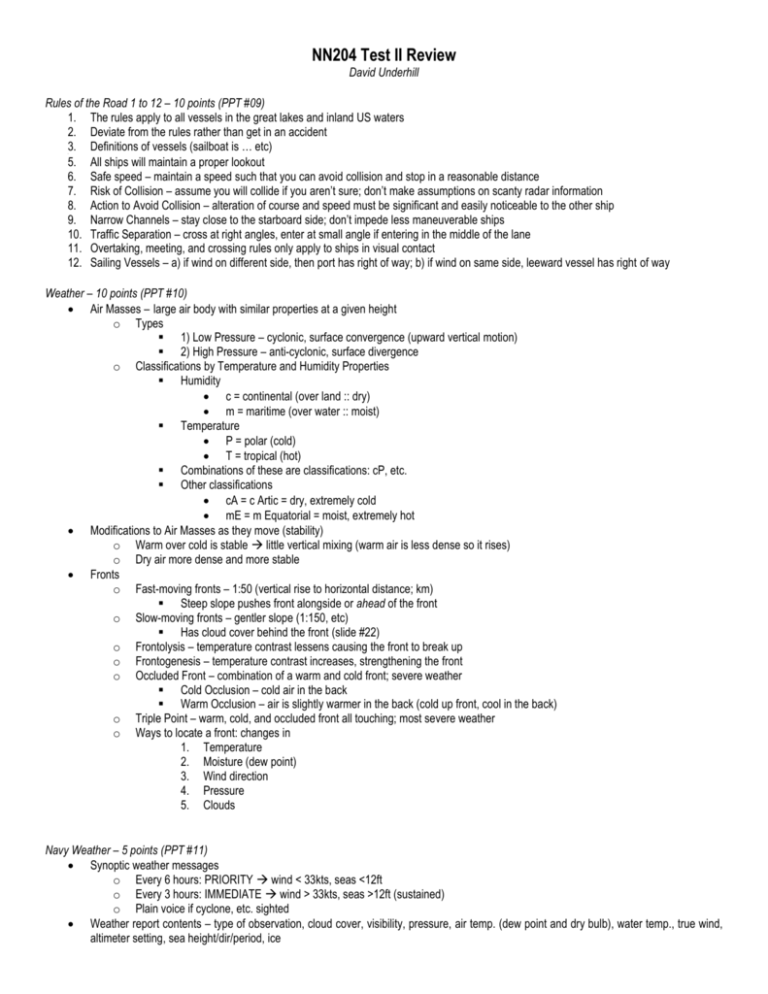
NN204 Test II Review David Underhill Rules of the Road 1 to 12 – 10 points (PPT #09) 1. The rules apply to all vessels in the great lakes and inland US waters 2. Deviate from the rules rather than get in an accident 3. Definitions of vessels (sailboat is … etc) 5. All ships will maintain a proper lookout 6. Safe speed – maintain a speed such that you can avoid collision and stop in a reasonable distance 7. Risk of Collision – assume you will collide if you aren’t sure; don’t make assumptions on scanty radar information 8. Action to Avoid Collision – alteration of course and speed must be significant and easily noticeable to the other ship 9. Narrow Channels – stay close to the starboard side; don’t impede less maneuverable ships 10. Traffic Separation – cross at right angles, enter at small angle if entering in the middle of the lane 11. Overtaking, meeting, and crossing rules only apply to ships in visual contact 12. Sailing Vessels – a) if wind on different side, then port has right of way; b) if wind on same side, leeward vessel has right of way 4. Weather – 10 points (PPT #10) Air Masses – large air body with similar properties at a given height o Types 1) Low Pressure – cyclonic, surface convergence (upward vertical motion) 2) High Pressure – anti-cyclonic, surface divergence o Classifications by Temperature and Humidity Properties Humidity c = continental (over land :: dry) m = maritime (over water :: moist) Temperature P = polar (cold) T = tropical (hot) Combinations of these are classifications: cP, etc. Other classifications cA = c Artic = dry, extremely cold mE = m Equatorial = moist, extremely hot Modifications to Air Masses as they move (stability) o Warm over cold is stable little vertical mixing (warm air is less dense so it rises) o Dry air more dense and more stable Fronts o Fast-moving fronts – 1:50 (vertical rise to horizontal distance; km) Steep slope pushes front alongside or ahead of the front o Slow-moving fronts – gentler slope (1:150, etc) Has cloud cover behind the front (slide #22) o Frontolysis – temperature contrast lessens causing the front to break up o Frontogenesis – temperature contrast increases, strengthening the front o Occluded Front – combination of a warm and cold front; severe weather Cold Occlusion – cold air in the back Warm Occlusion – air is slightly warmer in the back (cold up front, cool in the back) o Triple Point – warm, cold, and occluded front all touching; most severe weather o Ways to locate a front: changes in 1. Temperature 2. Moisture (dew point) 3. Wind direction 4. Pressure 5. Clouds Navy Weather – 5 points (PPT #11) Synoptic weather messages o Every 6 hours: PRIORITY wind < 33kts, seas <12ft o Every 3 hours: IMMEDIATE wind > 33kts, seas >12ft (sustained) o Plain voice if cyclone, etc. sighted Weather report contents – type of observation, cloud cover, visibility, pressure, air temp. (dew point and dry bulb), water temp., true wind, altimeter setting, sea height/dir/period, ice Services available o Tropical Cyclone Alert o High Wind and Seas Warning o Local Severe Storms Warning o WEAX – forecast request in MOVEREP; periodic o OTSR – Optimum Track Ship Routing – ship specific weather and safe track Hurricane conditions of readiness (for shore when winds > 50kts, for ships when winds >35kts) o Condition of Readiness (COR) IV – 72hrs … COR III – 48 hrs … COR II – 24hrs … COR I – 12 hrs Weather changes o Sand storms near Iraq o Decreased comms, radar equipment performance drops during bad atmospheric conditions o Fog forms when the dew point temp approaches the dry bulb temp (within 3°) o Worsening conditions: falling barometer, wind shifts, sea swells, cloud patterns Tropical Storm – 8 points (PPT #12) Heavy weather terms o Closed cyclonic – rotating storms Tornado – violent rotating storm, small diameter, over land, >150mph Waterspout – tornado over water (less destructive) Squall – intense wind due to atmospheric instability; comes and goes quickly; sometimes accompanied by precipitation Monsoon – steady winds with frequent squalls and thunderstorms Tropical Storm Types (based on wind speed): Hurricane > 63kts Tropical Storm 34 to 63kts Tropical Depression < 34 knots o Noncyclonic – produced by prevailing winds; predictable Gale: 34-47mph … Storm: >48mph Semicircles o Evasion in the Dangerous Semicircle 1) Get wind on the stbd bow (45° rel) 2) Make headway 3) Hold wind on the stbd bow 4) The storm will pass astern o Evasion in the Less Dangerous Semicircle – same as above except get the wind on your starboard quarter (130° rel) o Evasion on the Storm Track 1) Get wind on the stb quarter (160° rel) 2) Run for less dangerous semi-circle 3) If wind stays the same or moves clockwise, then you are still in its path 4) Once winds shift to counter-clockwise, you are in the less dangerous semi-circle (follow its evasion procedure) o Never cross in front of a storm (“crossing the T”) Sunrise/Sunset – 7 points (PPT #13) Sunrise – when the sun’s upper limb (UL) comes above the horizon Sunset – when the sun’s UL goes below the horizon Civil Twilight – when the sun’s center is 6° from the horizon o Clear horizon; 1st and 2nd magnitude stars visible Nautical Twilight – when the sun’s center is 12° from the horizon until Civil Twilight o First chance to shoot a celestial fix 15° = 1 hr Sunrise is earlier for those in the east Calculating sunrise/sunset 1. Determine approximate position 2. Apply latitude correction 3. Apply longitude correction (use closest std meridian) Days longer in summer (N hemisphere) b/c N tilts towards the sun; occurs between 21 Mar (Vernal E) and 22 Sep (Autumnal Equinox) Tropic of Cancer (north) and Tropic of Capricorn (south); 23.5° latitude from equator o Sun is directly overhead at solstices: 21 June (Cancer) and 21 Dec (Capricorn) Celestial Navigation Theory – 20 points (PPT #14, 14a) Celestial Sphere Elements (PPT14) Celestial Sphere – infinite radius with its center on Earth; has a North and South Celestial Pole and Celestial Equator (in line with Earth’s) Hour Circle – great circles going through the poles of the celestial sphere Celestial Meridian – great circles through the poles and zenith Declination – degrees above or below the celestial equator (0 is on it, 90 is upwards from the pole…) Parallel of Declination – circle parallel to the celestial equator; path on which a star appears to move as the Earth rotates Identifying a point on the celestial sphere – requires declination and an hour angle o Hour angles are from 0 to 360° and referenced from one of three types: Sidereal Hour Angle (SHA) - angle west of vernal equinox (Aries) Greenwich Hour Angle (GHA) – angle west of Greenwich celestial meridian Local Hour Angle (LHA) angle west of the observer’s celestial meridian o Which references are used by different bodies SHA: stars GHA: sun, moon, planets, and Aries Motion Earth rotates clockwise which makes the celestial sphere appear to move slowly counter-clockwise (diurnal motion) GHAstar = GHAAries + SHAStar LHAstar = LHAAries + SHAStar GHAstar = LHAstar + longitude Elements of the Horizon Coordinate System Zenith – position directly above the observer Nadir – directly below the observer Observer’s Horizon – perpendicular to zenith-nadir line / axis Celest. Horizon – parallel to observer’s horizon but passes through center of the Earth Altitude – star’s angle above the horizon Sextant Altitude (Hs) – altitude measured by a sextant Corrected Sextant Altitude (Hc) – Hs corrected for height of eye Observed Altitude (Ho) – altitude after further corrections made to Hc Vertical Circle – great circle that passes through zenith and nadir; perp. to the celest. horizon Principal Vertical Circle – v. circle passing through the N and S celest. poles Zenith – angle from the direction of the north pole to the angle where the altitude is measured (angle from the principle vertical circle to the vertical circle on which the star lies) Geographic Position – point on earth over which a star is located (found by drawing a line from the star to the center of the Earth) Celestial Triangles o Three points: (North) Celestial Pole, Celestial Body, Observer’s Zenith o Three sides: Co-altitude – from zenith to celestial body = 90° - altitude Co-latitude – from zenith to celestial pole = 90° – latitude Polar Distance – angular dist. from celest body to celest pole = 90° +/- declin. Add 90 if the celestial body and pole are in different hemispheres; subtract if in the same hemisphere o Three inner angles (two important ones): Meridian angle (-t-) – at celestial pole; related to LHA Azimuth Angle (-Z-) – at zenith o Note: Given latitude, declination, and a meridian angle, you may solve for altitude and azimuth angle PPT14a Light from a star hits Earth at an angle (changes over time as the Earth moves, etc) Co-altitude – angle between your position and a star’s GP; angle from the vertical; = 90 - Ho Circle of Equal Altitudes – a set of points on a circle centered on the star’s GP on which the altitude appears the same for the star o Radius is the co-altitude … 1min arc = 1nm so if co-alt. is 40 then your distance from GP is 40*60’/deg * 1°/nm = 2400nm Getting a fix o True Azimuth – Zn – direction to the star’s GP … plot this o Plot circle of equal altitude which is a line perpendicular to the direction to the star’s GP o Intercept – the difference between radii of two circles of equal attitudes (on from Ho, one from Hc) Intercept is the distance between your DR position and LOP position along your DR track If Observed Altitude (Ho) > Computed Altitude (Hc) draw the LOP intercept distance closer to the GP than your DR Ho Mo To if Ho more then draw towards GP Otherwise, draw the LOP intercept distance away from the GP from your DR o Once you have three LOPs in this manner, you can get a running fix Latitude Determination by Local Apparent Noon or Polaris; Gyro Error – 10 points (PPT #15) Latitude by Local Apparent Noon o 1st Case: Latitude = Declination + 90° – Altitude sun in the same hemisphere; sun latitude < your latitude o 2nd Case: Latitude = Declination - 90° – Altitude sun in the same hemisphere; sun latitude > your latitude o 3rd Case: Latitude = 90° – Altitude - Declination sun in a different hemisphere Latitude by Polaris o Polaris – named because it is almost directly on the celestial north pole … makes the triangle “collapse” on itself so that: o Observed Altitude = Latitude o Colatitude = Coaltitude o Polaris is actually ¾° off of the pole – a correction table is in the Nautical Almanac Gyro Error by Polaris o Usable in the northern hemisphere between the equator and 65° latitude o Maximum desired Observed Altitude (Ho) is 25° o Compare Ho to value in the Nautical Almanac; difference between the two determines gyro error Gyro Error by Sun Azimuth o Compare calculated and observed azimuth of the sun; difference between the two determines gyro error Moboards – 10 points Stella – 20 points
